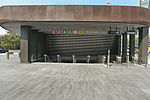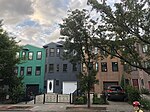Grand Avenue station (BMT Fulton Street Line)
Grand Avenue was a station on the demolished BMT Fulton Street Line in Brooklyn, New York City. It opened on April 24, 1888, and had two tracks and two offset side platforms. It was served by trains of the BMT Fulton Street Line, and until 1920, trains of the BMT Brighton Line. The station was also the easternmost station to share the original Brighton Line trains before branching off to the south at the Franklin Avenue el station, the site of the present-day Franklin Avenue subway station. It also had connections to Putnam Avenue Line trolleys. The next stop to the east was Franklin Avenue. The next stop to the west was Vanderbilt Avenue. In 1936, the Independent Subway System built the Fulton Street subway, but provided no station as competition. The el station became obsolete, and it closed on May 31, 1940.
Excerpt from the Wikipedia article Grand Avenue station (BMT Fulton Street Line) (License: CC BY-SA 3.0, Authors).Grand Avenue station (BMT Fulton Street Line)
Bergen Street, New York Brooklyn
Geographical coordinates (GPS) Address Nearby Places Show on map
Geographical coordinates (GPS)
| Latitude | Longitude |
|---|---|
| N 40.682382 ° | E -73.979255 ° |
Address
Bergen Street 357
11217 New York, Brooklyn
New York, United States
Open on Google Maps








